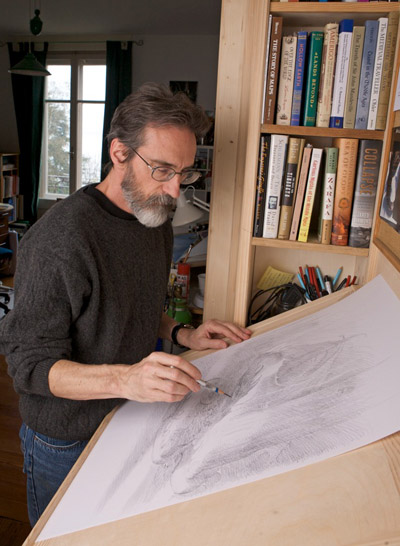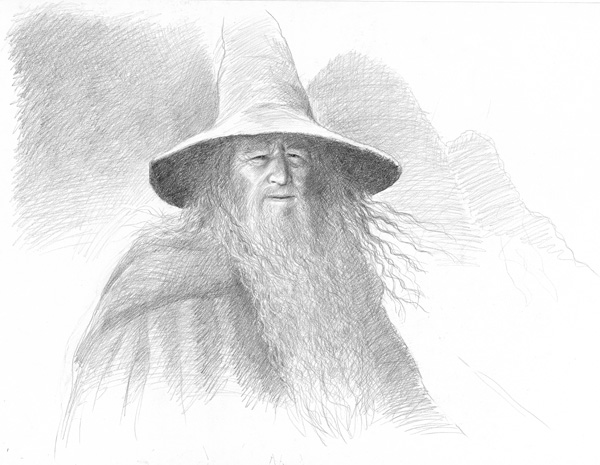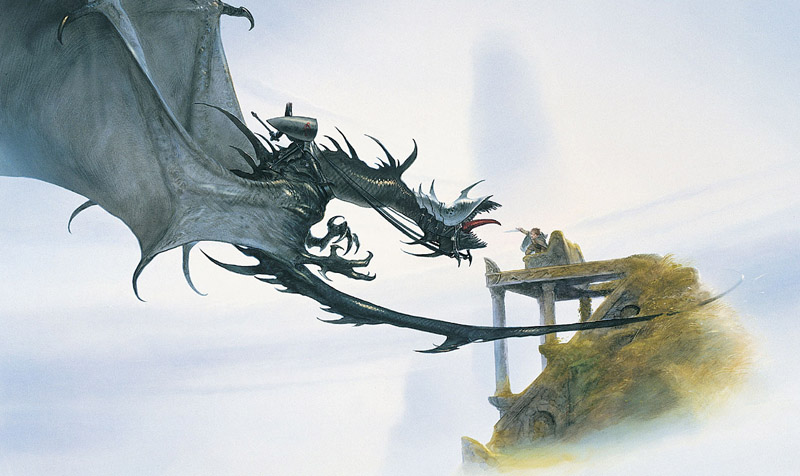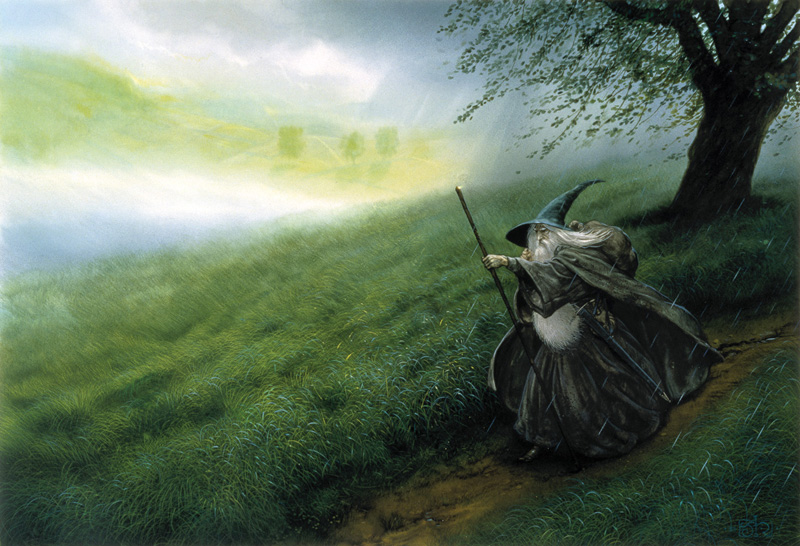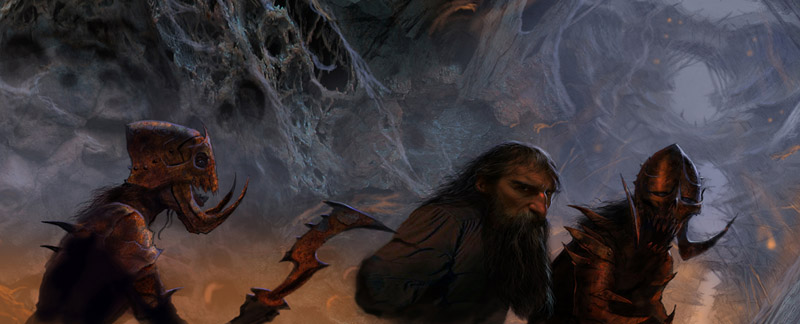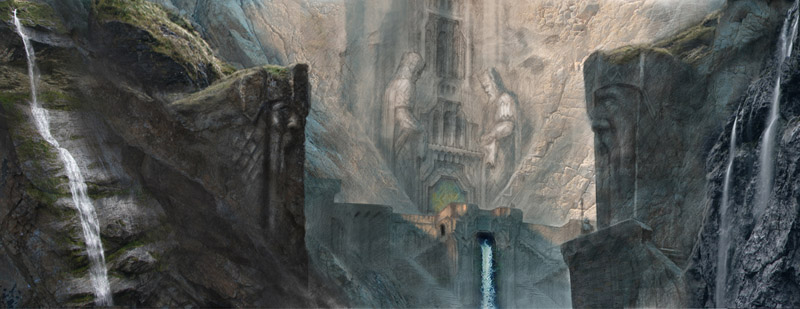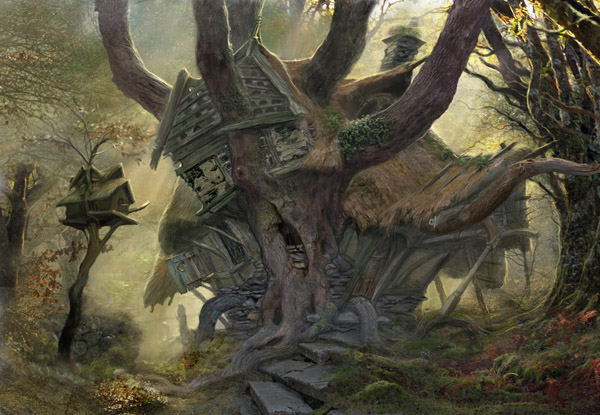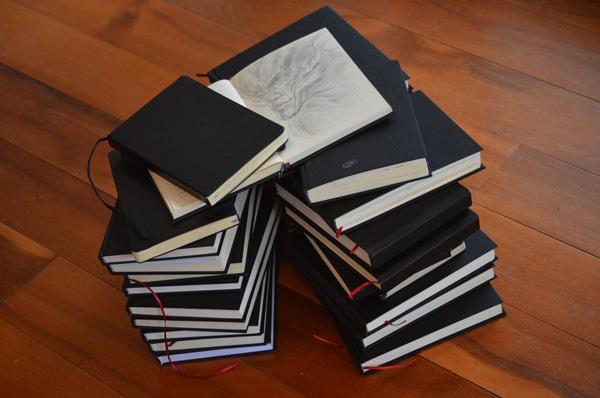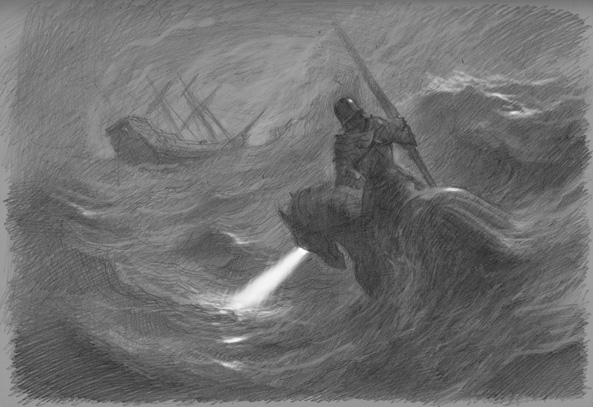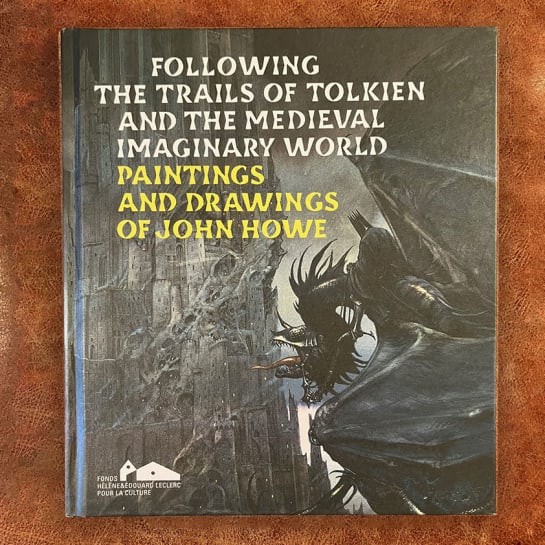Photograph by Kim Sayer
[/one_third]
[two_third_last]
With an enviable back catalogue of published fantasy illustration, avid sketch book advocate John Howe is without doubt one of the most recognisable names in the industry, not least because of his pivotal role in the creation of characters heavily featured in the film adaptations of Tolkien’s The Hobbit and The Lord of the Rings. Here we discover more about his work process, where he finds inspiration and his experiences behind the scenes on a movie set.
Sir Ian McKellen as Gandalf
Your exquisite line work is incredibly detailed and appears to reflect the environment around you, tell us a little about where you seek inspiration?
Inspiration is everywhere. I try to spend a lot of time wandering in wilder parts of the landscape, or visiting historical sites, both incredibly fertile in material and information, I think to be inspired your mind needs to be empty of thought, but full of visually rich material nonetheless, in order to be spontaneous and truly creative.
Your dragons are known the world over not least because of their inclusion in the film adaptations of J R R Tolkien’s The Hobbit, Is mythology something you are drawn to and which mythological creatures do you most enjoy illustrating?
I’m very attracted to myth in general, so I’ll have to say all of them. I enjoy painting creatures of undefined proportions, embodiments of elemental forces, as well as the more familiar figures of folk-tale.
Frodo and the Nazgul
What’s the most rewarding aspect of your job?
The best part is the sentiment of independence, not knowing what you might be drawing in a few weeks’ time. I enjoy working at home, and working with clients the world over.
Which three pieces of advice would you give to budding illustrators?
Be passionate.
Be patient.
Be tough.
Passionate, because you are your work, when it comes to the bottom line.
Patient, because you can’t create in a vacuum. Illustration is a communication art; you are saying something with your work, in the hope that what you have to say will be heard and appreciated.
Tough, because you will be opening intimate convictions to all sorts of criticism and judgements.
If you could illustrate any classic book which would you choose?
I would love to illustrate a retelling of Norse myth, or H.P. Lovecraft’s Dream-Quest of Unknown Kadath. I would also love to illustrate one of Tolkien’s novels some time, or anything by Robert Holdstock or Robin Hobb.
For many illustrators the space in which they work is key to providing inspiration and focus, Do you have a separate studio space? Can you tell us what is on your desk and what you can see out of the window?
I do have to turn my head, but our studio has a lovely view out over the Lake of Neuchâtel. We have a second, smaller studio space, which is dedicated to the digital side of things, but which also contains my drawing “pulpit”. I enjoy drawing standing up, because of the freedom of movement.
Lake of Neuchâtel
How does it feel when you see your work published, and which piece have you been most proud of?
I enjoy seeing work published, despite the occasional disappointments with printing, because that really is the form it is meant to take. I suppose that the illustration that I least feel I need to go back and fix is the Gandalf the Grey, done for a HarperCollins calendar in 1987.
Gandalf the Grey
For the past five years your working life has been dominated by The Hobbit, has working in the film industry changed the way in which you work?
It has, without a doubt! It’s certainly augmented my familiarity with film-making, from pre-production all the way through to post-production. It was a terrific learning experience. It also gave me the possibility to pick up Photoshop, both a blessing and a burden. These last few years have been spent working almost entirely in Photoshop, but I hope to find some balance between paints and pixels in my illustration work.
dwarves in the goblin caves
Dwarf kingdom of Erebor
Rhosgobel, the wizard Radagast the Brown’s house.
Do you keep a sketch book and if so can you show us one of your favourite pages?
Yes, one of my few truly reliable qualities is my faithfulness to sketchbooks! Sketchbook are the most wonderful things. Every page is an invitation.
I carry a sketchbook almost everywhere – I recall a wonderful day spent on the shores of Lake Pukaki, in the middle of New Zealand’s South Island, comfortably seated under a tree on the edge of a camp filled with bedraggled-looking extras dressed in damp Laketown costumes, happily drawing gigantic dwarven statues for Erebor, we whiled the day away, me sketching, Alan making Kili’s talisman with a dremel and a stone from the lake.
I always advise against buying spiral-bound sketchbooks. It is far too easy to tear out a page, and the most precious sketches are the ones that don’t work. If you fear ruining the very first page of a brand-new sketchbook with a bad drawing? The answer is simple: start in the middle.
John Howe The Hobbit Sketchbooks
You are renowned for your incredible attention to detail and historical and anatomical accuracy, can you tell us a bit about your research process when creating artwork?
Research never stops, I’m interested in everything, really, from paving stone patterns to Polish winged hussars, from Celtic knotwork to Scythian myth, architecture, art, history, it is all fascinating.
We spend a lot of time in museums, noses up against the glass, peering intently at old and broken things, when I’m scrutinizing a broken potsherd, I’m not just seeing the dusty fragment of fired clay, I’m imagining the potter, how he or she lived, their world, their culture.
We can never get closer to these long departed human beings than through the objects created by their hands, heads and hearts. Because that’s what it’s all about isn’t it? Everything tells a story, and telling stories, over and over, in their complexity and variety of form, is what makes us human.
Stormjaeger
With huge thanks to John for providing such insightful and inspirational answers to our questions.
You can find out more about John and his work by visiting his website
www.john-howe.com
[/two_third_last]
